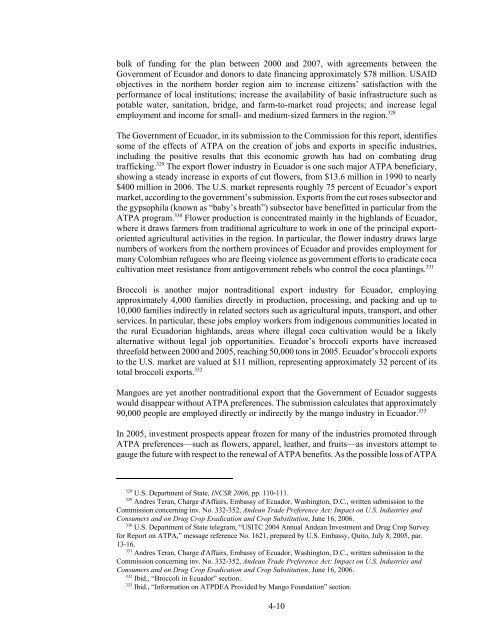The Impact of the Andean Trade Preference Act Twelfth ... - USITC
The Impact of the Andean Trade Preference Act Twelfth ... - USITC
The Impact of the Andean Trade Preference Act Twelfth ... - USITC
- No tags were found...
Create successful ePaper yourself
Turn your PDF publications into a flip-book with our unique Google optimized e-Paper software.
ulk <strong>of</strong> funding for <strong>the</strong> plan between 2000 and 2007, with agreements between <strong>the</strong>Government <strong>of</strong> Ecuador and donors to date financing approximately $78 million. USAIDobjectives in <strong>the</strong> nor<strong>the</strong>rn border region aim to increase citizens’ satisfaction with <strong>the</strong>performance <strong>of</strong> local institutions; increase <strong>the</strong> availability <strong>of</strong> basic infrastructure such aspotable water, sanitation, bridge, and farm-to-market road projects; and increase legalemployment and income for small- and medium-sized farmers in <strong>the</strong> region. 328<strong>The</strong> Government <strong>of</strong> Ecuador, in its submission to <strong>the</strong> Commission for this report, identifiessome <strong>of</strong> <strong>the</strong> effects <strong>of</strong> ATPA on <strong>the</strong> creation <strong>of</strong> jobs and exports in specific industries,including <strong>the</strong> positive results that this economic growth has had on combating drugtrafficking. 329 <strong>The</strong> export flower industry in Ecuador is one such major ATPA beneficiary,showing a steady increase in exports <strong>of</strong> cut flowers, from $13.6 million in 1990 to nearly$400 million in 2006. <strong>The</strong> U.S. market represents roughly 75 percent <strong>of</strong> Ecuador’s exportmarket, according to <strong>the</strong> government’s submission. Exports from <strong>the</strong> cut roses subsector and<strong>the</strong> gypsophila (known as “baby’s breath”) subsector have benefitted in particular from <strong>the</strong>ATPA program. 330 Flower production is concentrated mainly in <strong>the</strong> highlands <strong>of</strong> Ecuador,where it draws farmers from traditional agriculture to work in one <strong>of</strong> <strong>the</strong> principal exportorientedagricultural activities in <strong>the</strong> region. In particular, <strong>the</strong> flower industry draws largenumbers <strong>of</strong> workers from <strong>the</strong> nor<strong>the</strong>rn provinces <strong>of</strong> Ecuador and provides employment formany Colombian refugees who are fleeing violence as government efforts to eradicate cocacultivation meet resistance from antigovernment rebels who control <strong>the</strong> coca plantings. 331Broccoli is ano<strong>the</strong>r major nontraditional export industry for Ecuador, employingapproximately 4,000 families directly in production, processing, and packing and up to10,000 families indirectly in related sectors such as agricultural inputs, transport, and o<strong>the</strong>rservices. In particular, <strong>the</strong>se jobs employ workers from indigenous communities located in<strong>the</strong> rural Ecuadorian highlands, areas where illegal coca cultivation would be a likelyalternative without legal job opportunities. Ecuador’s broccoli exports have increasedthreefold between 2000 and 2005, reaching 50,000 tons in 2005. Ecuador’s broccoli exportsto <strong>the</strong> U.S. market are valued at $11 million, representing approximately 32 percent <strong>of</strong> itstotal broccoli exports. 332Mangoes are yet ano<strong>the</strong>r nontraditional export that <strong>the</strong> Government <strong>of</strong> Ecuador suggestswould disappear without ATPA preferences. <strong>The</strong> submission calculates that approximately90,000 people are employed directly or indirectly by <strong>the</strong> mango industry in Ecuador. 333In 2005, investment prospects appear frozen for many <strong>of</strong> <strong>the</strong> industries promoted throughATPA preferences—such as flowers, apparel, lea<strong>the</strong>r, and fruits—as investors attempt togauge <strong>the</strong> future with respect to <strong>the</strong> renewal <strong>of</strong> ATPA benefits. As <strong>the</strong> possible loss <strong>of</strong> ATPA328U.S. Department <strong>of</strong> State, INCSR 2006, pp. 110-111.329Andres Teran, Charge d'Affairs, Embassy <strong>of</strong> Ecuador, Washington, D.C., written submission to <strong>the</strong>Commission concerning inv. No. 332-352, <strong>Andean</strong> <strong>Trade</strong> <strong>Preference</strong> <strong>Act</strong>: <strong>Impact</strong> on U.S. Industries andConsumers and on Drug Crop Eradication and Crop Substitution, June 16, 2006.330 U.S. Department <strong>of</strong> State telegram, “<strong>USITC</strong> 2004 Annual <strong>Andean</strong> Investment and Drug Crop Surveyfor Report on ATPA,” message reference No. 1621, prepared by U.S. Embassy, Quito, July 8, 2005, par.13-16.331 Andres Teran, Charge d'Affairs, Embassy <strong>of</strong> Ecuador, Washington, D.C., written submission to <strong>the</strong>Commission concerning inv. No. 332-352, <strong>Andean</strong> <strong>Trade</strong> <strong>Preference</strong> <strong>Act</strong>: <strong>Impact</strong> on U.S. Industries andConsumers and on Drug Crop Eradication and Crop Substitution, June 16, 2006.332Ibid., “Broccoli in Ecuador” section.333 Ibid., “Information on ATPDEA Provided by Mango Foundation” section.4-10
















